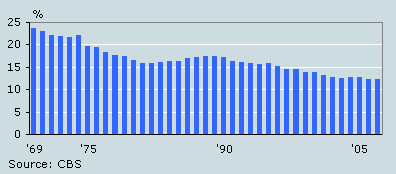Manufacturing output growth slackening

In 2008, the growth rate of Dutch manufacturing output is substantially down on 2006 and 2007 as the figures referring to the period January–September show. In the past few years, the growth of Dutch manufacturing output has also been less substantial than in other eurozone countries. Dutch economic growth, on the other hand, exceeded the average economic growth in the eurozone almost continuously.
Average daily manufacturing output

Manufacturing industry contributes less to Dutch economy
In the past decades, the Dutch economy has shifted from manufacturing goods to providing services. Manufacturers have gradually become less important. By the end of the 1960s, the gross value added generated by Dutch manufacturing industry still accounted for nearly a quarter of Gross Domestic Product (GDP). Subsequently, manufacturing industry has gradually become less prominent. The contribution of agriculture and fisheries and the construction sector also became less substantial in the course of time. Amongst services providers, the growth of value added in the financial and business services sector is most notable. Its contribution to the GDP more than doubled from 11 percent by the end of the 1960s to 25 percent in 2007. Price and volume changes played an important part in this respect.
Gross value added generated by manufacturing industry, contribution to GDP

Metal industry contributes most to manufacturing value added
In 2007, gross value added generated by the manufacturing sector amounted to 69 billion euro. With 32 percent, the largest contribution was made by the metal industry, followed by petroleum, chemicals, rubber and plastics and food, drinks and tobacco. Altogether, these three sectors generated three quarters of gross value added in the manufacturing sector. With less than 2 percent, the smallest contribution was made by the textiles, clothes and leather industry.
Sectors in manufacturing, share in gross value added, 2007
